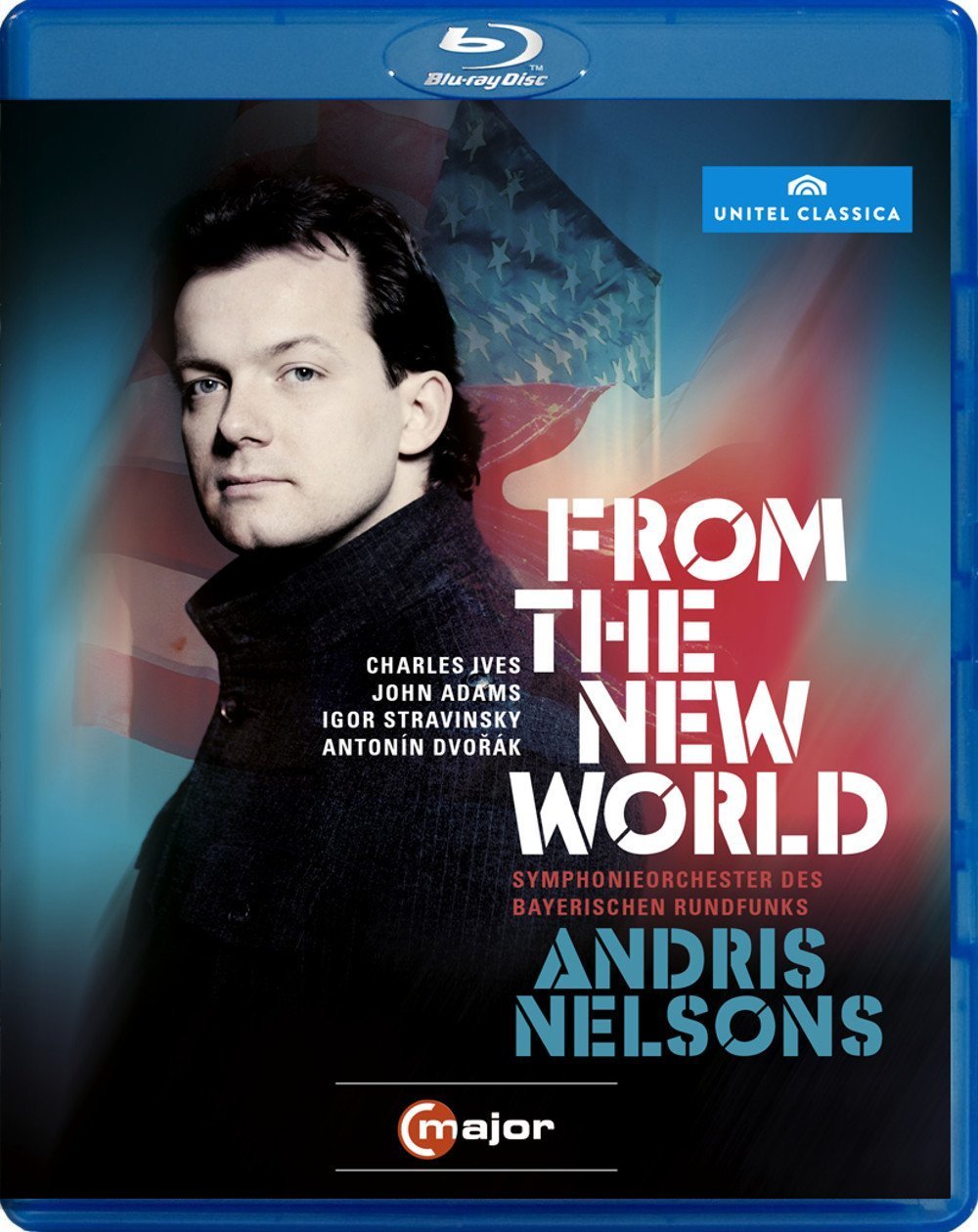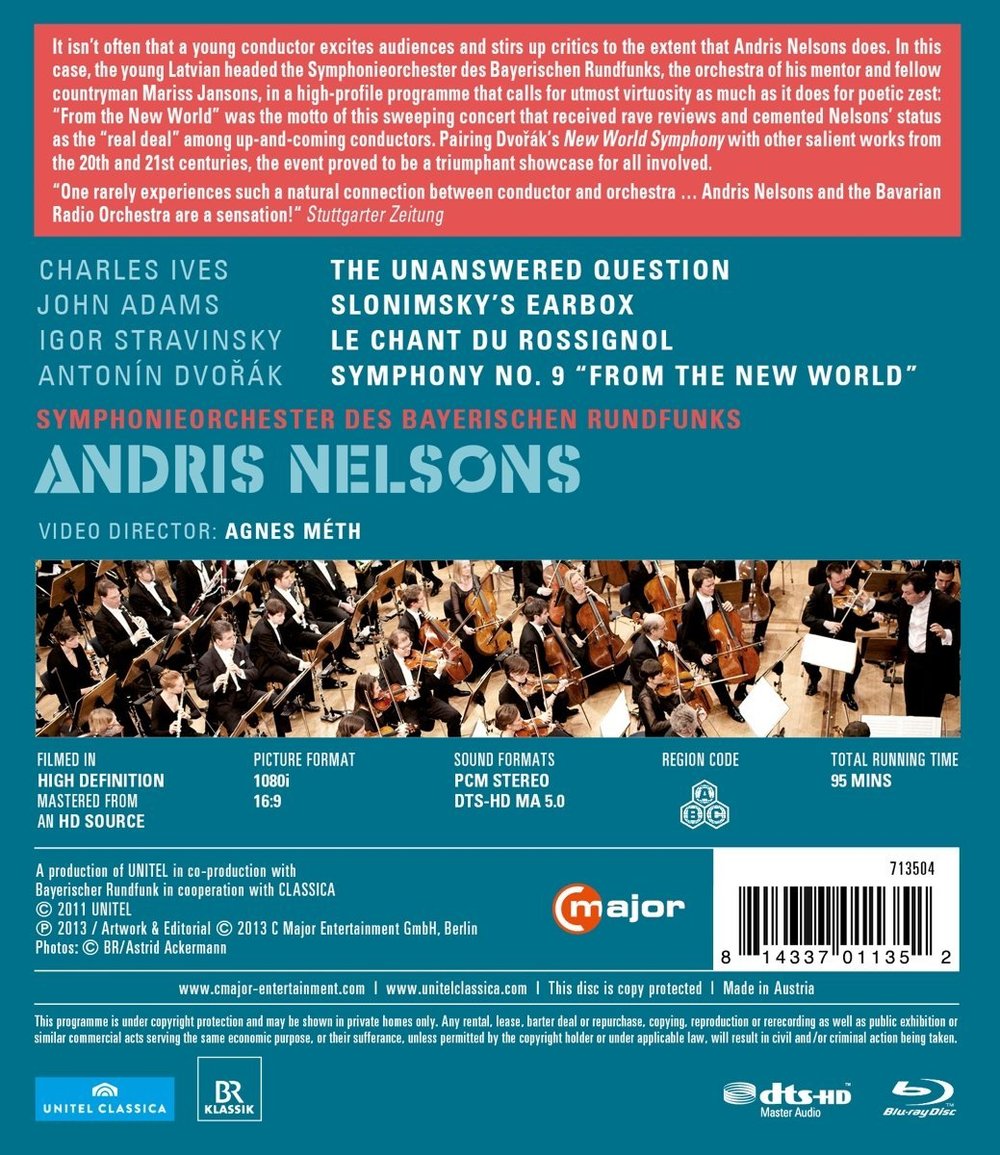

From the New World symphony concert. In 2010 Andris Nelsons directs the Bavarian Radio Symphony Orchestra (Symphonieorchester des Bayerischen Rundfunks) at the Herkulessaal in Munich pieces related to the New World:
Charles Ives The Unanswered Question (American composer)
John Adams Slonimsky's Earbox (American composer)
Igor Stravinsky Le Chant du Rossignol (Song of the Nightingale) (Stravinsky lived in Los Angeles longer than in any other city)
Dvořák Symphony No. 9 "From the New World" (inspired by Dvořák's experiences in America)
Perhaps you could make a case that all of these pieces explore "new worlds" of music as all of the composers lived in the 20th century (Dvořák just barely). Directed for TV by Agnes Méth. Released 2013, disc has 5.0 dts-HD Master Audio sound. Grade: D
Print critic Rob Cowan in the October 2013 Gramophone (page 59) states that "Nelsons is a real boon, perhaps the most visually likable conductor since Carlos Kleiber, his gestures clear, his facial expressions warmly appreciative of everything in the music that moves him." Below are some examples of Nelsons' face making; some love it and others consider him a disruptive clown. These are not shots of spectacularly exciting points in the concert — he pretty much looks like this constantly:
Cowan loved this recording as did Michael Cookson and Leslie Wright, in separate reports for musicweb-international.com, and Robert Cummings writing for Classical Net Review. I agree this was an excellent performance of interesting music well-recorded as to sound. But I have reservations about video content. But before we get into my critique, I'll show you some more screenshots.
The Unanswered Question
This is one of Ives' most popular pieces, perhaps because you just don't have time to get tired of it in 5 and 1/2 minutes. Like much of Ives, it's unlike anything else you have experienced. First, an outside-the-hall string orchestra provides a somewhat static foundation similar in feeling to the Barber Adagio for Strings. Second, a solo trumpet (also offstage) asks 7 wistful questions in a mood similar to the strings. All the audience sees is an on-stage quartet of flautists (can be other woodwinds) which answers the trumpeted questions in increasingly aggressive and profuse strains of premeditated art. All this is most atmospherically performed and filmed.
Next below, from inside the hall, we have an image of the strings outside of an entrance to the hall (with workers in the rear cleaning around the concession stand):
During the performance, this is a typical view of the strings from a different angle (a whole-orchestra shot!)
Below are two shots of the four flautists on-stage. The first shot, made before the performance begins, shows an open stage door in the back. This is the little room where the trumpet player hides. The trumpeter makes his first and only video appearance during the applause:
And here are the flautists desperately trying and failing (I guess) to find the answer:
Slonimsky’s Earbox and Le chant du rossignol
The next two pieces on the program are unmistakably Stravinskian, although only one is actually composed by him. The 1st is Slonimsky’s Earbox by John Adams, which lasts about 14 minutes. The Adams piece was inspired by Igor Stravinsky's 20-minute long symphonic poem Le chant du rossignol (The Song of the Nightingale). To help readers understand the sound world they may be stepping into, the Adams Slonimsky’s Earbox reminds me of the 1st movement of the Stravinsky Symphony of Psalms. The Le chant du rossignol reminds me of the Rite of Spring.
I'll say just a bit more about the Adams piece. Slonimsky was a Russian composer and musicologist who wrote The Thesaurus of Scales and Melodic Patterns, a book that Adams admired and used as a composer. "Earbox" is apparently not a dictionary word in English (I think it may have been coined by Adams). The word is now used in obscure ways, and there is a company that makes a "hoodie" wind-breaker jacket called "The Earbox".) Here "earbox" means a collection of musical techniques for composer of modern music. According to wikipedia, Adams says that Slonimsky's Earbox "memorializes Slonimsky's wit and hyper-energetic activity." I supose another title for Slonimsky's Earbox could have been The Song of Slonimsky.
Since Slonimsky's Earbox is a sort of catalog of musical ideas (and Adams is alway a guy in a hurry), this is a very fast-paced work in performance. This presented a hidden trap for videographer Agnes Méth, and she fell into it: her Slonimsky's Earbox, with a video pace (by my careful count) of only 3.3 seconds per video clip, deserves an award as the fastest in the Guiness Book of Records.
I agree with the hdvdarts.com belief that it's bad practice to make a fast video of fast music. When I go to a live concert and hear a fast piece, I see the whole thing in one "video" clip. I have no problem following what's happening on the stage. I'm oriented, and my fast eyes, ears, and brain can easily follow the musical action. (This my ancesters learned to do over hundreds of thousands of years of battles with prey, enemies, and wildfires.) But when I see a new video clip, my brain must first get oriented. Then it must ask, "Now what am I seeing and why?" My brain is pretty good at this also, but it does cost time and energy each time a new clips appears. And after a few minutes of doing this every 3.3 seconds (on average), the brain starts to weary from all the unnecessary friction and overhead of the fast pace. This happens to me even though I'm experienced with symphony music and recordings. Novice symphony viewers will doubtless be taxed by the fast pace far more than I.
Now let's see a few screenshots from Slonimsky's Earbox. Next below are 2 part-orchestra (PO) shots. There are a fair number of nice shots like this, but some of them only last 1 second!
Along with the hyper-fast pace, Méth also has a tendency to serve up highly fragmented views of tiny parts of the orchestra. And because the cameramen are working so fast, we see many poorly-framed shots and problems with focus and depth-of-field-of-focus. Next below is an example of bad framing:
And what's the point of the next shot below:
The cameramen feel the lash like Roman sailors rowing a trireme. They make a lot of easy-to-frame-and-focus instrument-only shots (IO shots). I count more than 4 of these each minute of the video. Instrument-only shots are weak because they do not promote an “audience perspective” for viewers. And alas, many of them also have defects like we see below in the next two shots:
To be fair, not all the IO shots are bad. The next 2 instrument-only views prove that even a small amount of perspective can add to the sense of “being there” in the concert hall, versus looking through a microscope:
There were other "low value” shots. For example, see the next screenshot below with 3 different images blended into one (piano IO, violin IO, and a “conductor-over-back”). Call me old-fashioned, but I call antics like this low value:
Dvořák Symphony No. 9
Finally, here are some images from the Dvořák Symphony No. 9. First, a WO shot of the kind we demand:
An admirable shot of the 2nd violins:
But here a loss of focus during a fast panning sequence:
And several more weak IO shots:
Now it's time to give some grades. If you have read other reviews of symphony titles on hdvdarts.com, you may already know something about the disease "DVDitis" and how we grade.
Briefly, DVDitis is a malady that afflicts Blu-ray videos with content that is only appropriate for a DVD.
First, see our special article on how to make a decent video of a large orchestra for viewing on HD TV
Next, take a look at the Wonk Worksheet we use to accurately diagnose DVDitis in a Blu-ray symphony recording
Finally refer to our Wonk Worksheet Instructions
The resources above tell you how to determine the pace of a video (how many seconds the average video clip lasts). They also tell you how to distinguish between (1) large-scale video clips which we call "supershots" and which are appropriate for Blu-ray video, and (2) the small-scale shots that are appropriate for a DVD. You will learn how to figure what percentage of total clips are supershots. Finally the resources tell you how to figure what percentage of total clips are views of the conductor.
Once you have run the numbers, you can see how the title stacks up against the following standard:
A good HDVD (or Blu-ray) should have a slow pace with more than 10 seconds per video clip on average (longer the better). 20 to 40% (higher is better) of the clips should be large-scale "supershots" (whole-orchestra, part-orchestra, multiple-section, and large-section shots). Conductor shots should be less than 20% (way less really) of the clips in the video.
Now you are ready to digest the information in the table below where I have run the numbers on The Unanswered Question, Slonimsky's Earbox, and Movements 1 and 2 of Symphony No. 9. I've seen the whole disc enough times to represent to you that these samples are enough to reasonably grade the whole disc:
|
HDVDarts criterion |
Ives - Unanswered Question |
Adams – Slonimsky’s Earbox |
Dvořák – Symphony No.9: Mvt. I |
Dvořák – Symphony No.9: Mvt. II |
|
Duration (min:sec) |
5:32 |
13:51 |
12:06 |
12:48 |
|
Total number of clips |
19 |
254 |
185 |
87 |
|
Pace |
17.5 |
3.3 |
3.9 |
8.8 |
|
% Supershots |
47% |
13% |
23% |
9% |
|
% Conductor shots |
32% |
22% |
22% |
26% |
|
% Soloist(s) realistic |
63% |
Not applicable |
Not applicable |
Not applicable |
|
Grade for each title |
B |
F |
D- |
D- |
|
Rationale |
|
|
|
|
The fast pace and other characteristics of Méth's video result in a near fatal case of DVDitis. This was not necessarily Méth's fault. She was hired to make a DVD. Management then decided to package the DVD as a Blu-ray, and that is what we condemn. The Blu-ray is "better" than the DVD because it has higher resolution and maybe better sound. But it is obolete and deficient because it falls way short of the quality we know is possible if a symphony video is made from the beginning as an HDVD (an not a DVD). The folks who pay extra for the Blu-ray deserve a modern product.
Our grading standards allow, however, for further adjustments when indicated. I move the The Unanswered Question up to a B+ because it's such a rare treat and I think its better qualities make up partly for the excessive conductor shots. I move Slonimsky's Earbox (and Le Chant du Rossignol) up to a D- with the Dvořák Symphony No. 9. I give the whole disc a blended grade of D. I have given you fair warning. If you have a good reason to buy this disc, watching it will not do you harm.
(Heads up folks. Ultra HD Blu-ray, with 4K resolution and other new features, is coming, and we could start getting fine-arts titles in Ultra HD as soon as this fall. Will the publishers continue to use DVD content in 4K?)
(Wonk Balmer bought subject title, did the DVDits analysis, and wrote the first draft of this report. Wonk McFadyen added some text and editing.)
OR






















